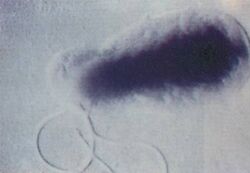Biology:Bartonella bacilliformis
| Bartonella bacilliformis | |
|---|---|

| |
| Bartonella bacterium | |
| Scientific classification | |
| Domain: | Bacteria |
| Phylum: | Pseudomonadota |
| Class: | Alphaproteobacteria |
| Order: | Hyphomicrobiales |
| Family: | Bartonellaceae |
| Genus: | Bartonella |
| Species: | B. bacilliformis
|
| Binomial name | |
| Bartonella bacilliformis (Strong et al. 1913) Strong et al. 1915
| |
| Synonyms | |
| |
Bartonella bacilliformis is a bacterium, Gram negative aerobic, pleomorphic, flagellated, motile, coccobacillary, 2–3 μm long, 0.2–0.5 μm wide, and a facultative intracellular bacterium.
History
The bacterium was discovered by Peruvian microbiologist Alberto Barton in 1905, but it was not published until 1909. Barton originally identified them as endoglobular structures, which actually were the bacteria living inside red blood cells. Until 1993, the genus Bartonella contained only one species; there are now more than 23 identified species, all of them within family Bartonellaceae.[1]
Epidemiology
Bartonella bacilliformis is found only in Peru, Ecuador, and Colombia and some areas of south Florida .[2] It is endemic in some areas of Peru, with outbreaks of the disease occurring in new epidemic areas.[3] The bacterium is transmitted by sandflies of the genus Lutzomyia.
Microbiology
For its isolation, special cultures are required, containing complemental soy agar, proteases, peptones, some essential amino acids, and blood. The optimum growing temperature is 19–29 °C. Colonies grow in Columbia blood agar supplemented with 10% defibrinated bovine blood incubated at 19–25 °C for 2 weeks.
Pathophysiology
As the sandflies bite, the bacteria are inoculated into the capillaries, where in a variable period of time (around 21 days) it invades the red blood cells producing severe intravascular hemolytic anemia (acute phase of Carrion's disease).[4] This phase is a potentially life-threatening infection, and it is associated with high fever, anemia, and transient immunosuppression. The acute phase typically lasts two to four weeks. Peripheral blood smears show anisomacrocytosis with many coccobacilli adhered to red blood cells. Thrombocytopenia is also seen and can be severe. Neurological involvement is sometimes seen (neurobartonellosis) and the prognosis in this case is poor. The most feared complications are super-infections, mainly by enterobacteria such as Salmonella, or parasites such as Toxoplasma gondii and Pneumocystis.
When the bacterium invades endothelial cells, it produces the chronic manifestation of the disease known as verruga peruana. This phase consists of a benign skin eruption with raised, reddish-purple nodules (angiomatous tumours). Visualization of the bacteria is possible using silver stain (the Warthin–Starry method) on biopsies.
Disease
Bartonella bacilliformis is the etiologic agent of Carrion's disease or Oroya fever (acute phase of infection), and verruga peruana or Peruvian wart (chronic phase of infection). The acute phase of the disease is a life-threatening disease characterized by massive invasion of Bartonella to human red blood cells and consequently acute hemolysis and fever. If the infection is not treated, the case fatality rate is 40 to 85%[5] Patients in this phase of the infection can be complicated by overwhelming infections, primarily by enterobacteria (Salmonella spp) and parasites (Toxoplasma gondii, Pneumocystis jirovecii). The chronic phase is characterized by benign eruptive lesions that are pruritic and bleeding, and other symptoms like malaise and osteoarticular pain.[2] Bartonella can be isolated from blood cultures and secretion of the lesions in people from endemic areas.[6]
Treatment
Before the antibiotic era, the only treatment for the acute phase was blood transfusion, but the effectiveness of this treatment was poor and the mortality rate was high.[7]
References
- ↑ "Genetic classification and differentiation of Bartonella species based on comparison of partial ftsZ gene sequences". J. Clin. Microbiol. 40 (10): 3641–7. 2002. doi:10.1128/JCM.40.10.3641-3647.2002. PMID 12354859.
- ↑ Jump up to: 2.0 2.1 "Bartonellosis (Carrión's disease) in the modern era". Clin. Infect. Dis. 33 (6): 772–9. September 2001. doi:10.1086/322614. PMID 11512081. http://www.journals.uchicago.edu/cgi-bin/resolve?CID001355.
- ↑ "Carrion's disease (Bartonellosis bacilliformis) confirmed by histopathology in the High Forest of Peru". Rev. Inst. Med. Trop. São Paulo 46 (3): 171–4. 2004. doi:10.1590/S0036-46652004000300010. PMID 15286824.
- ↑ Maguiña C. Bartonellosis o enfermedad de Carrión. Nuevos aspectos de una vieja enfermedad. AFA edit. Lima-Peru
- ↑ "Bartonellosis. New and old". Infect. Dis. Clin. North Am. 14 (1): 1–22, vii. March 2000. doi:10.1016/S0891-5520(05)70215-4. PMID 10738670.
- ↑ "Epidemiology of endemic Bartonella bacilliformis: a prospective cohort study in a Peruvian mountain valley community". J. Infect. Dis. 186 (7): 983–90. October 2002. doi:10.1086/344054. PMID 12232839. http://www.journals.uchicago.edu/cgi-bin/resolve?JID020197.
- ↑ Schultz MG (July 1968). "A history of bartonellosis (Carrión's disease)". Am. J. Trop. Med. Hyg. 17 (4): 503–15. doi:10.4269/ajtmh.1968.17.503. PMID 4876803.
External links
- Human Bartonellosis caused by Bartonella bacilliformis
- Bartonella bacilliformis in the NCBI Taxonomy Browser
Wikidata ☰ Q2007668 entry
 |

